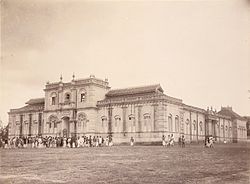List of Heritage Buildings in Mysore
This article contains a list of heritage monuments and edifices in and around Mysore city. The city of Mysore features a number of historical structures built before the Indian Independence as well as modern classical-architecture buildings raised since then.
The history of Mysore city, in particular, and of the Deccan Plateau in general, spans across both the pre- and post-Independence eras. Mysore is believed to have been formed into a republic even before the mythical times of Medieval India. The regions in and around the Mysore belts find mentioning from Vedic scripts, where the region is termed as Mahishaka (the mighty/great kingdom).
History
Over the centuries, before and after the Common Era, the region was ruled by different, numerous dynasties, mostly South Indian ones, like the
Patrons during Princely India
Most of the construction works undertaken by earlier empires and monarchies have either been completely destroyed over time, owing to rampages of the Deccan Sultanates, or have been dismantled by the following monarchies. However, most of the structures in Mysore City, and in fact, in the cities in the Kingdom of Mysore, which includes as close as Bangalore, Erode, Shimoga, Chitradurga, among others, were built between the early 1700s and the late 1940s, and are, hence, often attributed to the Wadiyars.
Since Mysore was the capital city of the kingdom for almost six centuries (excluding, of course, shifting the capital to Seringapatam for a brief period during Hyder Ali and Tipu Sultan's rule), the Wadiyars were directly supervising the construction and progress of the city. Construction in other Mysore Kingdom cities were delegated to subordinates, like that of Bangalore to Kempe Gowda I (between 1510 and 1569 under Chamaraja Wodeyar II and Chamaraja Wodeyar III), Shimoga to Shivappa Nayaka (between 1645 and 1660 under Kanthirava Narasaraja I), et cetera. After the decline of strong subordinates and the influence of British rule, the Wadiyars became principal, direct rulers of Mysore Kingdom, with supervisors mostly being the Diwans (Prime Ministers) of Mysore and British agents. Therefore, while other cities attribute their progress to the subordinates of the Wadiyars, Mysore credits all its progress to the Wadiyars. After the abolishment of absolute monarchy, most of the structures are being used by the democratic government bodies, like the Indian Government's using Cheluvamba Vilas Palace as CFTRI, University of Mysore's using Jayalakshmi Vilas Palace as University Museum and Oriental Research Library as Museum Library, and the Karnataka Government's using several palaces for tourism attraction, just to name a few within Mysore city.
List of Pre-Independence Edifices
| Year | Building | Name | Currently |
|---|---|---|---|
| Palaces | |||
| 1861 | 
|
Jaganmohana Palace | Currently, Shri Jayachamarajendra Arts Gallery and Jaganmohana Palace Arts and Crafts Museum |
| 1905 | 
|
Jayalakshmi Vilas Palace | Now, Jayalakshmi Vilas Mansion |
| 1912 | 
|
Mysore Palace | Palace: temporary tenant: Government of Karnataka; owners: the royal family |
| 1916 | 
|
Chittaranjan Palace | Currently, The Green Hotel, an eco-friendly hotel |
| 1918 | 
|
Cheluvamba Vilas Palace | Currently, Cheluvamba Vilas Mansion; used by CFTRI |
| 1921 | 
|
Lalithamahal Palace | Currently, The Lalitha Mahal Palace Hotel, a three-star hotel |
| 1924 | Rajendra Vilas Palace | Now, a private palace of the royal family | |
| Academic Buildings | |||
| 1840 | 
|
Hardwick High School | |
| 1851 | 
|
Maharaja's College | |
| 1876 | 
|
Marimallappa's High School | |
| 1887 | 
|
Oriental Research Institute Mysore | A national library |
| 1915 | 
|
Crawford Hall | University of Mysore |
| 1917 | 
|
Maharani's College
|
|
| 1917 | Chamarajendra Technical Institute | ||
| 1924 | 
|
Mysore Medical College | |
| Sri Chamarajendra Ursu Boarding School | |||
| 1927 | Yuvaraja's College | ||
| 1940 | 
|
D Banumaiah's Post-Graduation College | |
| 1940 | 
|
D Banumaiah's College of Commerce and Arts | |
| Government Buildings | |||
| 1840 | DC Office | ||
| 1895 | Public Offices | ||
| 1899 | Law Court Buildings | ||
| Public Buildings | |||
| 1870 | 
|
Railway Station | |
| 1879 | Lansdowne Building | Commercial Complex | |
| 1884 | 
|
Town Hall | |
| 1886 | Devaraja Market | Commercial Complex | |
| 1889 | 
|
Cheluvamba Hospital | |
| 1918 | 
|
Krishnarajendra Hospital | |
| Religious Buildings | |||
| 1670s | 
|
Chamundeshwari Temple | |
| 1810 | 
|
The Parakala Mutt | |
| 1933 | 
|
St Philomina's Church
|
|
| 1925 | Masjid E Azam | ||
